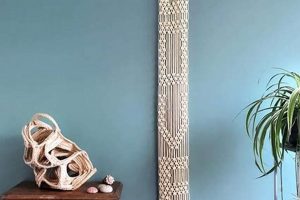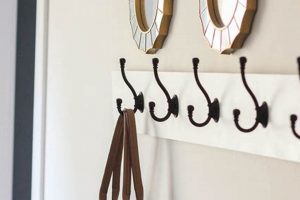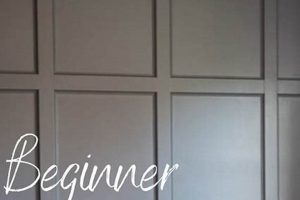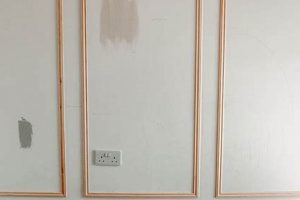Creating decorative textiles using knotting techniques, especially with a free-spirited, artistic aesthetic, represents a popular craft. This approach empowers individuals to produce personalized home decor items. For example, one might utilize natural fibers and a series of knots to construct an ornamental piece intended for vertical display.
The appeal of this craft stems from its accessibility, affordability, and the unique aesthetic it provides. Historically, the technique has roots in maritime traditions, but its current resurgence aligns with broader trends toward handcrafted goods and sustainable living. The resulting items often add texture, warmth, and visual interest to interior spaces.
The following sections will detail materials needed, fundamental knotting methods, and design considerations for undertaking such a project, offering a guide for crafting individualized textile art.
Essential Considerations for Textile Knotting Projects
Successful execution of decorative knotting projects requires careful planning and attention to detail. The following guidelines aim to optimize the process and enhance the final product.
Tip 1: Material Selection: Opt for natural fibers such as cotton, jute, or hemp for optimal texture and durability. Different fiber thicknesses will yield varying aesthetic results; experiment to determine the desired look.
Tip 2: Knot Consistency: Maintain uniform tension when executing knots. Inconsistent tension leads to uneven patterns and diminishes the overall visual appeal.
Tip 3: Measurement Accuracy: Precise measurement of cord lengths is crucial, especially when repeating knot patterns. Inaccurate measurements result in skewed designs and wasted materials.
Tip 4: Secure Mounting: Choose a sturdy mounting rod or dowel that can adequately support the weight of the finished piece. Ensure the mounting hardware is securely attached to the wall to prevent accidents.
Tip 5: Design Planning: Sketch out the intended design prior to commencing the project. This blueprint will serve as a guide and minimize errors during the knotting process.
Tip 6: Knot Variety: Explore diverse knotting techniques beyond basic square knots. Incorporating variations such as lark’s head knots, spiral knots, or clove hitch knots adds visual complexity and texture.
Tip 7: Finishing Touches: Upon completion, trim excess cord ends neatly for a polished appearance. Consider adding decorative elements such as wooden beads or feathers to further enhance the aesthetic.
Adhering to these recommendations will contribute to a more streamlined and satisfying crafting experience, resulting in a visually appealing and structurally sound final product.
The subsequent sections will elaborate on specific design options and advanced knotting techniques, enabling further customization and refinement of individual textile art projects.
1. Knotting Techniques
The creation of free-spirited, artistic textile art is fundamentally reliant on the mastery and application of various knotting techniques. These techniques dictate the texture, structure, and overall aesthetic of the finished piece.
- Square Knot Variations
The square knot forms the basis of many patterns. Alterations in knot tightness, spacing, and sequence result in diverse textures and visual effects. A tightly packed series creates a solid, dense panel, whereas a looser arrangement produces a more open, airy feel. Real-world examples include the creation of textured backdrops or patterned focal points within the art piece.
- Spiral Knot Application
The spiral knot, also known as the half knot sinnet, introduces a dynamic, flowing element. Consistent repetition generates a spiraling effect, adding visual movement. Its application can be seen in creating cascading fringe or decorative elements that frame the central design. This technique adds a tactile and visually engaging component.
- Lark’s Head Knot Integration
The lark’s head knot serves primarily as an attachment method, securing cords to a mounting rod. However, strategic placement and variation can contribute to the overall design. By alternating the direction of the knot, a subtle chevron pattern can be introduced. Examples include creating a textured header or establishing a repeating motif at the top of the piece.
- Clove Hitch Knot Utilization
The clove hitch knot offers a secure and adjustable means of attaching cords. Its adaptability allows for creating geometric patterns and defined lines. When grouped in a repeating sequence, it forms a durable and visually distinct element. This knot is frequently used to define borders or create structured elements within the design.
The interplay between these different knotting techniques determines the final character of the textile art. Mastery and creative application of these methods facilitate the realization of diverse artistic visions, transforming simple cords into intricate and expressive art forms.
2. Material Selection
The choice of materials significantly impacts the aesthetic appeal, durability, and overall success of free-spirited, artistic textile art projects. Careful consideration of fiber type, color, and texture is crucial for achieving the desired outcome and reflecting the intended artistic vision.
- Fiber Type and Texture
Natural fibers such as cotton, jute, and hemp possess inherent textural qualities that contribute to the piece’s visual and tactile appeal. Cotton offers a soft, pliable texture ideal for intricate knotwork, while jute and hemp provide a coarser, more rustic aesthetic. The selection directly influences the final product’s ability to embody the intended free-spirited artistic style. Using synthetic fibers may compromise the natural look, contradicting the core principles of the craft.
- Cord Thickness and Ply
Cord thickness affects the scale and definition of knots. Thicker cords create bolder, more prominent knots, suitable for larger pieces and simpler designs. Thinner cords allow for more intricate knotwork and finer detailing. The number of plies, or strands within the cord, influences its strength and texture; a higher ply count generally indicates increased durability and a smoother surface. Appropriate selection ensures structural integrity and visual harmony.
- Color Palette and Dyeing
The color palette sets the overall mood and aesthetic tone. Natural, undyed fibers evoke a sense of earthy simplicity, while dyed fibers allow for greater creative expression. Natural dyes, derived from plants or minerals, align with the craft’s organic origins and produce subtle, nuanced colors. Synthetic dyes offer a wider range of vibrant hues but may deviate from the traditional aesthetic. Color choices must complement the intended design and the overall interior space.
- Hardware and Embellishments
The mounting rod or dowel should be chosen to support the weight of the finished piece and complement its aesthetic. Natural wood dowels enhance the organic feel, while metal rods provide a more modern look. Embellishments such as wooden beads, feathers, or shells can further enhance the artistic expression, adding texture, color, and visual interest. The integration of these elements contributes to the unique character of the finished product.
These material considerations underscore the importance of a deliberate and informed approach. The selection process directly influences the final product’s visual appeal, structural integrity, and ability to capture the intended free-spirited and artistic nature. By thoughtfully considering fiber type, cord thickness, color palette, and embellishments, creators can craft pieces that authentically reflect their artistic vision and enhance any living space.
3. Design Inspiration
Design inspiration serves as the foundational catalyst for artistic textile art projects, directly influencing the aesthetic direction, knotting patterns, and overall visual narrative. The incorporation of Bohemian (boho) elements within such designs necessitates a conscious engagement with specific source materials. These sources may include natural landscapes, vintage textiles, cultural motifs, or abstract artistic expressions. Without a clear source of inspiration, the resultant piece risks lacking cohesion and a distinct visual identity. For instance, a design inspired by the color palette of a desert landscape might utilize varying shades of beige, terracotta, and ochre, translating these colors into specific cord choices and knot patterns to evoke the intended environment. A design inspired by a traditional textile pattern may be adapted to macrame form, preserving essential shapes while reinterpreting them through knotting techniques.
The practical application of design inspiration manifests in the preliminary stages of project planning. A detailed sketch, color palette, and knotting sequence are often developed based on the chosen inspiration. This blueprint ensures that the final piece aligns with the initial artistic vision. Furthermore, the selection of materials, such as specific types of cord or embellishments, is often guided by the design source. For example, a project inspired by nautical themes might incorporate jute cords and wooden beads to evoke a maritime aesthetic. The successful translation of design inspiration into a tangible product requires a combination of technical skill and artistic sensibility. A clear understanding of the source material and its inherent characteristics is essential for effective implementation.
In summary, design inspiration is an indispensable component of producing visually compelling and artistically meaningful decorative textile art. Its absence can lead to that lack focus and visual depth. The effective utilization of design inspiration necessitates a careful analysis of source materials, meticulous planning, and a skillful application of knotting techniques. Challenges may arise in translating abstract concepts into concrete forms, requiring creativity and adaptability. Ultimately, a strong connection to a defined source of inspiration elevates the final piece, transforming it from a mere craft project into a work of art.
4. Mounting Method
The selection and implementation of a suitable mounting method represent a critical stage in the creation of decorative textile art. This process directly affects the stability, presentation, and longevity of the finished piece, impacting its overall visual appeal and functional integration within the intended environment. Inadequate mounting can compromise the integrity of the work, detracting from its artistic value and potentially leading to damage or instability.
- Hardware Selection and Weight Distribution
The choice of hanging hardware, including nails, hooks, or screws, must align with the weight and dimensions of the mounted textile art. Incorrect hardware selection poses a safety risk and can damage both the art piece and the supporting wall. Even distribution of weight is critical to prevent stress on individual cords or knots, which can lead to structural failure over time. For example, a heavier piece requires multiple points of attachment to distribute the load evenly across the mounting rod or frame.
- Rod or Dowel Integrity
The supporting rod or dowel serves as the primary structural element from which the knotted textile art is suspended. Its material composition, diameter, and length must be carefully considered to ensure adequate support and prevent bending or breakage. Natural wood dowels offer a rustic aesthetic but may be susceptible to warping or cracking under significant weight. Metal rods provide greater strength and durability but may detract from the piece’s natural or Bohemian aesthetic. The chosen rod should be seamlessly integrated into the design and capable of withstanding the intended load.
- Hanging Angle and Visual Display
The hanging angle significantly influences the visual presentation of the finished piece. Adjustments to the hanging hardware or the length of the suspension cords can alter the angle, emphasizing certain design elements or correcting for uneven wall surfaces. A level suspension is generally preferred to maintain visual balance and prevent distortion of the knotted patterns. Consideration should also be given to the surrounding environment, including lighting and viewing distance, to optimize the visual impact.
- Concealment and Aesthetic Integration
The mounting method should ideally be discreet and unobtrusive, allowing the focus to remain on the knotted textile art itself. Concealed mounting hardware, such as flush-mounted brackets or hidden suspension cords, can minimize visual distractions and enhance the overall aesthetic. The chosen method should also complement the style and materials of the piece, seamlessly integrating the mounting apparatus into the overall design. For instance, using natural twine to suspend a piece from a wooden dowel reinforces the natural and free-spirited character.
These facets highlight the multifaceted nature of the mounting process and its direct impact on the aesthetic and functional success of decorative textile art. A well-executed mounting method not only ensures the stability and longevity of the piece but also enhances its visual appeal, allowing it to seamlessly integrate into and complement the intended environment. Conversely, a poorly executed mounting method can detract from the overall effect, diminishing the artistic value and potentially compromising the piece’s structural integrity.
5. Finishing Details
Finishing details significantly contribute to the overall aesthetic and perceived value of a textile art piece. These encompass a range of actions undertaken upon completion of the primary knotting process, affecting both the visual presentation and structural integrity. Trimming excess cord ends, securing loose knots, and adding embellishments are all considered finishing details. The omission of these steps frequently results in a piece that appears unrefined and incomplete, detracting from the intended free-spirited and artistic style. Conversely, meticulous attention to these details elevates the final product, enhancing its visual appeal and contributing to a polished, professional appearance. For example, neatly trimming fringe to a uniform length creates a sense of order and intention, while strategically placed wooden beads or feathers can accentuate specific design elements and reinforce the overall aesthetic.
Practical applications of understanding the importance of finishing details extend to the perceived market value and potential for commercial success. A piece with carefully executed finishing details commands a higher price point than one lacking such attention. Furthermore, the longevity and durability of the piece are enhanced through proper finishing techniques. Securing loose knots prevents unraveling and maintains the structural integrity of the design over time. Applying a sealant or stiffening agent to the cord can further protect it from wear and tear, ensuring that the piece retains its beauty and functionality for years to come. Consider the addition of a backing material to provide a clean, professional reverse side and protect the wall from potential scratching. These seemingly small details collectively contribute to a significant improvement in the overall quality and value.
In summary, finishing details are not merely cosmetic enhancements but essential components. Their meticulous execution directly affects the aesthetic appeal, structural integrity, and perceived value of a textile art creation. Overlooking these steps diminishes the artistic impact and potential longevity, while their careful implementation elevates the piece to a higher level of craftsmanship. Challenges in mastering finishing techniques often involve achieving uniformity and precision, requiring patience and attention to detail. Recognizing the connection between these elements and the overall success of a project fosters a commitment to quality, transforming a simple craft into a refined art form.
Frequently Asked Questions
The following section addresses common inquiries and misconceptions regarding the creation and maintenance of handcrafted textile art.
Question 1: What is the expected lifespan of a textile art piece, and how can its longevity be maximized?
The lifespan varies depending on material quality, environmental conditions, and maintenance practices. Employing durable, natural fibers, avoiding direct sunlight exposure, and implementing regular gentle cleaning procedures can extend the lifespan considerably. Proper knot securing and reinforcement during construction are also crucial factors.
Question 2: Is specialized equipment required to undertake a textile art project, or can common household tools suffice?
While specialized tools such as macrame boards and knotting needles can enhance precision and efficiency, basic projects can be completed with common household items. Scissors, measuring tapes, and a sturdy mounting surface are typically sufficient for introductory endeavors.
Question 3: How does the choice of knotting patterns impact the structural integrity and visual appeal of the final product?
Different knotting patterns offer varying degrees of structural stability and visual texture. Denser patterns provide greater support and a more solid appearance, while open patterns offer a lighter, more airy aesthetic. Careful selection of patterns appropriate for the intended design and weight requirements is essential.
Question 4: What are the recommended methods for cleaning and maintaining textile art pieces, and what cleaning agents should be avoided?
Gentle hand washing with mild soap and cool water is generally recommended. Harsh chemicals, abrasive cleaners, and machine washing should be avoided, as they can damage the fibers and distort the knotting patterns. Regular dusting with a soft brush can help prevent the accumulation of dirt and debris.
Question 5: How can one effectively translate a source of design inspiration, such as a photograph or abstract concept, into a tangible textile art design?
Begin by isolating key elements from the source, such as color palettes, geometric shapes, or textural patterns. Translate these elements into specific knotting techniques, cord thicknesses, and embellishment choices. Sketching the design beforehand and creating a sample swatch can aid in visualizing the final product.
Question 6: What are the most common challenges encountered by novice textile artists, and how can these challenges be overcome?
Common challenges include inconsistent knot tension, inaccurate cord measurements, and difficulty interpreting complex patterns. Practicing basic knots repeatedly, utilizing accurate measuring tools, and seeking guidance from online tutorials or experienced artisans can help overcome these hurdles.
These answers provide a foundation for understanding the complexities and nuances involved in textile art creation. Continued exploration and experimentation will further refine one’s skills and enhance the artistic outcome.
The following section will provide a conclusion to the topic of textile art creation.
Conclusion
The preceding sections have explored various facets of decorative textile knotting projects, encompassing material selection, knotting techniques, design inspiration, mounting methods, and finishing details. Each element contributes significantly to the overall aesthetic, structural integrity, and perceived value of the final product. A comprehensive understanding of these principles is essential for successful project execution and the creation of visually compelling artwork.
The pursuit of excellence in textile arts demands meticulous attention to detail, a commitment to continuous learning, and a willingness to experiment with diverse techniques and materials. The ability to translate artistic visions into tangible forms represents a valuable skill, contributing to both personal enrichment and the preservation of traditional crafts. The creation of decorative textile art is a testament to human ingenuity and the enduring power of handcrafted artistry.







